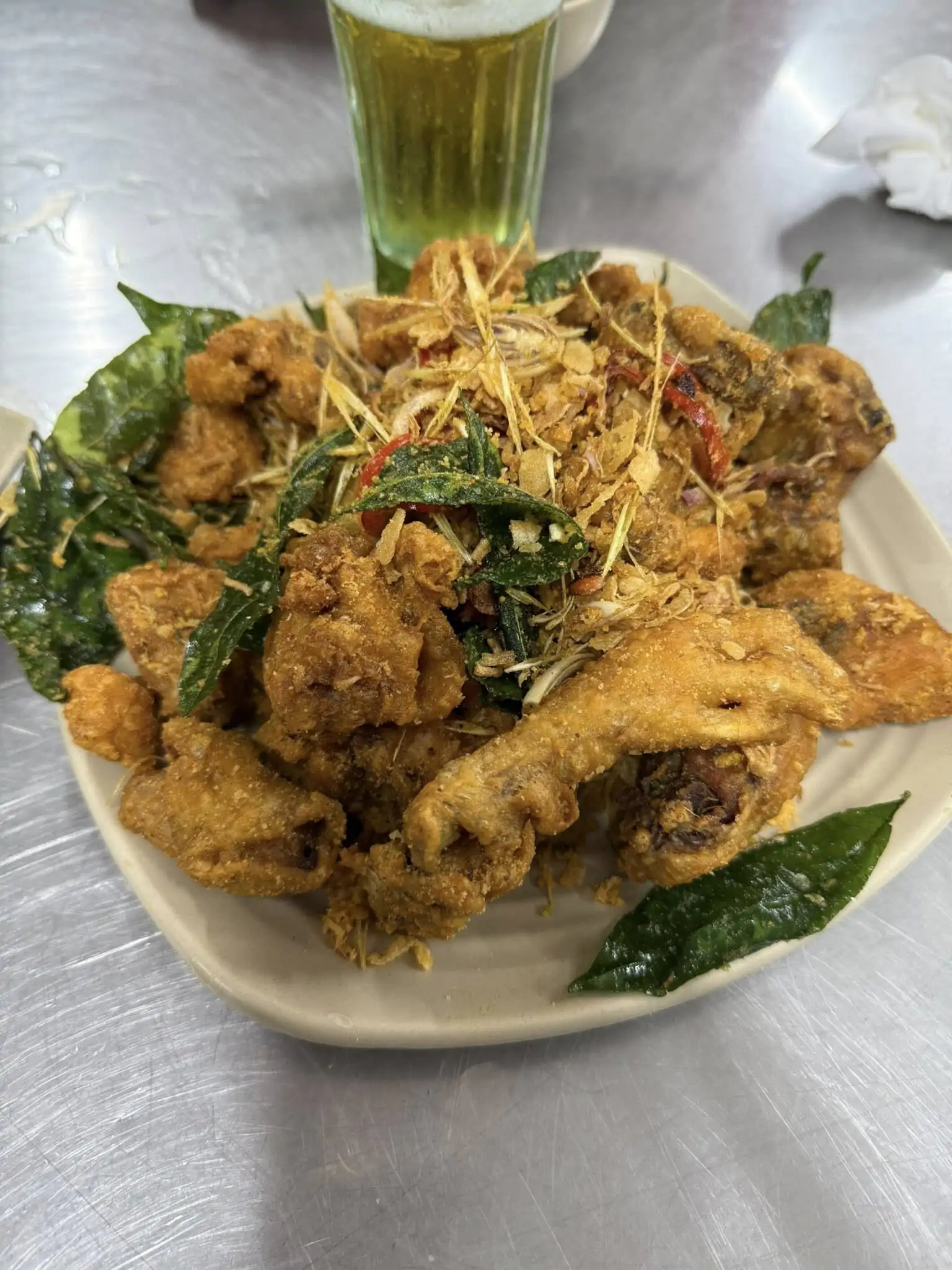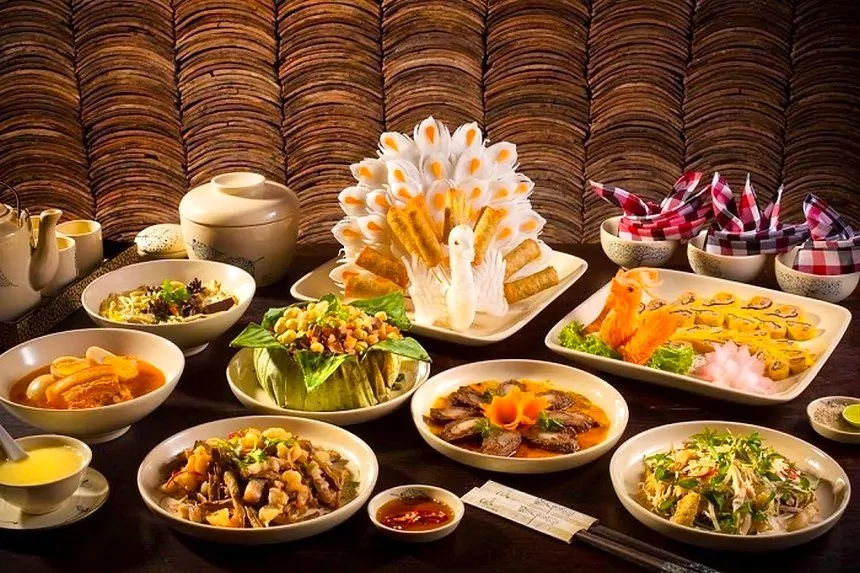Contents
Khánh Hòa, a coastal province in central Vietnam, is not only famous for its white sandy beaches, entertainment resorts, and luxurious resorts in Nha Trang but also renowned for its coastal villages and the traditional cultural traits of its people. When visiting Khánh Hòa, besides exploring the city of Nha Trang, tourists should not miss a trip to the rural areas to experience the local life here. Hon Khoi salt fields are a fascinating destination for those interested in the daily activities of the local people.
Location: Hon Khoi, Ninh Hai Commune, Ninh Hoa District, Khanh Hoa Province
Opening hours: 04.00 AM – 08.00 AM and 03.00 PM – 06.00 PM
Entrance fee: no charge
Best for: traveling in groups, photographers
I. Highlights of Hon Khoi Salt Fields

1. History of Hon Khoi
According to the oral tradition of the local villagers, the name Hon Khoi originates from a historical event in the 18th century. At that time, the remaining troops of the Ming Dynasty in China, who refused to surrender to the Qing Dynasty, sailed southward to settle in Vietnam. Some wealthy individuals with better conditions could reach southern Vietnam, while others wandered the seas and became pirates.
Sometimes, these Chinese pirates raided the offshore islands and coastal villages. Upon noticing the situation, the Nguyen Dynasty in Vietnam ordered that whenever pirates appeared and threatened the villagers, they should light fires on mountaintops to create smoke signals for local officials to come to their aid. Hence, this area was called Hon Khoi, which means “smoky island.”
Closely associated with the name Hon Khoi are the salt fields that have sustained generations of people in this region. Only by visiting Hon Khoi can tourists truly appreciate the beauty of the salt workers, who are not only hardworking and resilient but also friendly and hospitable.

2. The Beauty of Hon Khoi Salt Fields
It can be said that the beauty of the Hon Khoi Salt Fields lies in the beauty of its people – the beauty of the salt workers laboring in the fields.
The Hon Khoi Salt Fields are one of the largest salt-making areas in central Vietnam, covering nearly 400 hectares and producing nearly 740,000 tons of salt annually. This work not only helps the local people sustain their livelihoods but also makes Hon Khoi a destination of interest for many tourists.
Salt production is a lengthy and challenging process that requires significant human effort and is highly dependent on nature. Seawater is pumped into large fields and left to evaporate under the sun until all the water evaporates. The more sunlight there is on the fields, the faster this process occurs. Despite working in such harsh conditions, salt workers still maintain a strong bond with their work as it is the cradle that nurtures their lives.
On the way to the Hon Khoi Salt Fields, tourists can smell the salt and feel the hot sea breeze blowing in. Upon arrival, visitors can admire the shimmering salt fields glistening under the sunlight. The reflective surface of the salt fields mirrors the clear blue sky and the people, creating an impressive picture of the local people’s work in the Hon Khoi Salt Fields.
Salt-making is by no means an easy task and demands perseverance, physical strength, and diligence. In the Hon Khoi salt fields, men are responsible for scraping and collecting salt into piles, while women carry the sea salt to processing areas in their bamboo frames. The pace of work in the Hon Khoi Salt Fields is quite hectic and busy from early morning to late evening.
Most of the salt workers in the fields are middle-aged women. To protect themselves from the harsh working conditions, they wear long-sleeved jackets, gloves, face masks, and conical hats. Despite their sun-tanned skin under the scorching heat, they still greet tourists with warm smiles. The image of women wearing conical hats carrying salt burdens on their shoulders is certainly the most impressive sight that tourists can witness in the Hon Khoi Salt Fields.
Featured in recent international newspapers and magazines, the Hon Khoi Salt Fields in Khanh Hoa Province immediately attract the attention of many domestic and international tourists, especially photography enthusiasts. At dawn and dusk, the entire field turns into a giant golden mirror reflecting the first and last rays of light of the day.
II. What to See and Do in Hon Khoi Salt Fields?

1. Taking gorgeous photos
Being dubbed as the “white snow in summer” landscape, the Hon Khoi Salt Fields are an ideal location for photography. At every moment of the day, the fields have their own beauty, but early morning and late afternoon are considered the best times. The perfect combination of the sky, the fields, and the people creates a dreamy backdrop, allowing tourists to capture dazzling photos without the need for Photoshop editing. Therefore, the Hon Khoi Salt Fields not only attract amateur photographers but also many professional photographers.

2. Experiencing a day of a salt worker
The Hon Khoi Salt Fields may not be an eco-tourism destination with high-quality tourism services, but tourists still have the opportunity to experience the life of the salt workers here. The local people’s working hours are from 4:00 a.m. to 8:00 a.m. and from 3:30 p.m. to 6:00 p.m. During these times, the weather is not too hot, suitable for outdoor activities. Other times of the day, with harsh conditions, are not ideal choices. Making an effort to engage in the daily tasks of the salt workers will allow you to empathize with the difficult life of the people of Hon Khoi and appreciate their work in every grain of salt you consume daily.
3. Visiting Doc Let Beach
Another must-visit tourist destination when visiting the Hon Khoi Salt Fields is Doc Let Beach, an untouched area in Ninh Hoa District. Similar to most beaches in Nha Trang, Doc Let Beach boasts crystal-clear and tranquil waters along a 2.5 km stretch of white sand. On the sandy beach, coconut groves stretch out, providing shade for tourists to relax and enjoy drinks. Not far from the shore are green islands rising and falling in the waves. On a hot summer day, there’s nothing more delightful than immersing yourself in the cool, clear waters of the beach.
4. Enjoying local foods
Khánh Hòa in general, and Hon Khoi in particular, are renowned for freshly caught seafood cooked to perfection. A variety of seafood including fish, crab, shrimp, and squid are transformed into delicious dishes with rich, flavorful tastes that reflect the essence of the Khanh Hoa sea. Moreover, in Ninh Hoa District, nem nuong (grilled pork sausage) is a specialty that no one should miss. The freshness and sweetness of the meat and vegetables rolled together create a unique flavor that cannot be found anywhere else in Vietnam.
III. Best Time to Visit Hon Khoi Salt Fields
The salt harvesting season in the Hon Khoi Salt Fields is from January to July every year. The period from April to June is considered the best time to obtain high-quality salt because it’s the hottest and sunniest time of the year. Therefore, despite the high temperatures, this time is actually the ideal period for tourism activities.
If you want to meet the salt workers in the Hon Khoi Salt Fields, you should start your journey at 4:00 a.m. and 3:30 p.m. After 8:00 a.m., tourists may see vast and tranquil fields, with only the white color of salt and the blue color of the sky.
Midday is not recommended as it can be extremely hot and may pose health issues for visitors.
IV. How to Get to Hon Khoi Salt Fields?
The Hon Khoi Salt Fields, located in Ninh Hoa District, are approximately 40km from Nha Trang City, so you can travel there by car, taxi, or motorbike.
From Nha Trang City, you can take National Highway 1C and then National Highway 1A to reach Ninh Diem Ward, Ninh Hoa District. Here, you turn right to reach the Hon Khoi Salt Fields. It takes about 1 hour and 10 minutes by car or taxi and 1.5 hours by motorbike to reach the Hon Khoi Salt Fields.
V. Extra Tips
The weather in Hon Khoi is relatively hot throughout the day, so you should prepare a wide-brimmed hat or cap, long-sleeved clothing, sunscreen, and water.
Avoid visiting the Hon Khoi Salt Fields at midday due to the extremely scorching weather.
If you want to experience the salt-making activities of the local people, you can politely ask for their permission.
Doc Let Beach is a prominent spot to end your day trip to Ninh Hoa.
Some specialties you should try when visiting Hon Khoi and Ninh Hoa include nem nuong (grilled pork sausage), bun ca (fish noodle soup), goi Lua (rice paper salad), and various seafood dishes.
If you have the opportunity to visit Nha Trang, Khanh Hoa, do not miss the chance to visit the Hon Khoi Salt Fields. This landscape allows you to experience the diligent labor of the local people, witness their work, and admire the simple beauty of the salt fields. The stunning scenery and friendly people will leave a lasting impression on every visitor to the Hon Khoi Salt Fields.
When planning a trip to Nha Trang, aside from Hon Khoi Island, you should consider visiting other fantastic destinations such as VinPearl Land Nha Trang, Van Phong Bay, Ninh Van Bay, Hon Tre Island and Whale Island. etc.. These places offer diverse experiences, ranging from pristine beaches and bustling cities to charming historical sites and enchanting landscapes.
To ensure the best vacation experience in Vietnam, it’s important to plan and book in advance. Among the many tour companies offering services in Vietnam, Discover Vietnam Tours is a great option for arranging your travel itinerary with just a few emails and WhatsApp messages. They provide airport transfers, accommodation booking, tour guides, drivers, and customizable activities based on your preferences.
With their assistance, you can tailor your trip according to your desired schedule and preferences, ensuring a seamless and enjoyable travel experience throughout Vietnam.

























